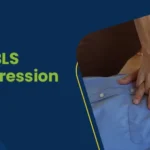Table of Contents:
- Introduction
- How Common is Maternal Cardiac Arrest?
- Cardiac Arrests in Pregnancy: Signs, Symptoms and Causes
- Some Safety Concerns During AED
- Steps to perform an AED on pregnant women
- Common Mistakes to Avoid During AED
- Wrapping Up
Sudden Cardiac Arrests can happen to anybody– even pregnant people! Well! Maternal cardiac arrest is a more vulnerable condition as it affects both the mother and child. While it is an alarming condition, you can learn about performing AED on pregnant women and become a life-saver for two beings at once!
AED training is a training course that provides knowledge on how to give first aid safely and effectively when someone suffers from cardiac arrest, including pregnant women.
An AED is a portable device that treats cardiac conditions by diagnosing and defibrillating patients automatically. The device restores the affected person’s normal heart rate, facilitating bystanders’ saving of lives even if they don’t have a medical background.
In this blog, we will discuss the steps required to use an AED on a pregnant woman. By the end of this blog, you will know what you should consider while using AED.
Master ACLS Now
Get ACLS certified with confidence
How Common is Maternal Cardiac Arrest?
Although maternal cardiac arrest is not a much more common condition than other ailments during pregnancy, it still affects a lot of women globally.
According to the reports, approximately 69% out of the 1465 women (aged 12-55) experiencing cardiac arrest survived. The researchers report that 1 in 9,000 women admitted for delivery in the United States suffer from cardiac arrest. Thus, mandating CPR in the hospital setting is very crucial to improving the condition of pregnant women.
Women, especially those who are pregnant, are 27% less likely to receive out-of-hospital CPR than men. It is because responders feel if they inflict harm on them during CPR. Thus, it is essential to identify the importance of CPR through an AED for pregnant women.
Cardiac Arrests in Pregnancy: Signs, Symptoms and Causes
Cardiac arrest in pregnancy simply means suffering from heart-related problems while you are pregnant. About 1 to 4% of total pregnancies get complicated due to cardiovascular diseases. There are two kinds of heart problems during pregnancy:
- Pre Existing heart problem: These cardiovascular diseases occur within you before you become pregnant
- Heart conditions develop during pregnancy: In this condition, you don’t have any heart-related ailments before pregnancy. Some heart conditions may be harmless, while others can be dangerous.
Let us understand what are the causes of cardiac arrest in pregnancy. While there are a lot of factors that make expecting women vulnerable to cardiac arrest, we have listed its common causes.
- Peripartum Cardiomyopathy: It is a form of heart failure that occurs at the end of pregnancy or after delivery. However, PPCM is widely diagnosed in the last month of pregnancy and remains up to five months of the postpartum period.
- Amniotic Fluid Embolism: Amniotic fluid embolism is a rare heart condition. It is a life-threatening complication that generally occurs when a pregnant woman gets amniotic fluid into their blood before, during, or after childbirth.
- Eclampsia: Eclampsia is a kind of seizures that occur in pregnant people with preeclampsia. It generally occurs in the later stage of pregnancy. The symptoms of eclampsia include:
- High blood pressure
- Headaches
- Blurry vision
- Convulsions
- Pulmonary Embolism: A pulmonary embolism is a blood clot that hinders and blocks the blood flow to the cases, the blood clot starts in the deep vein in the leg and travels toward the lung. However, blood clots can also form in other parts of the body.
Here are the three broad categories of SCA in pregnant women for a better outlook.
-
- Obstetric: The causes of obstetrics include eclampsia, hemorrhage, and amniotic fluid embolism.
- Non-obstetric: The primary non-obstetric causes include pulmonary embolism, septic, and preexisting cardiovascular diseases.
- Iatrogenic: The causes of iatrogenic include anesthetic complications during pregnancy.
Signs and Symptoms
The signs and symptoms of cardiac arrest in pregnant women are similar to other patients. However, physiological changes during pregnancy can make a condition more complicated. The key signs and symptoms include:
- Losing consciousness
- Lack of palpable pulse
- Abnormal breathing or no breathing at all
- Dizziness or lightheadedness
- Chest pain
- Shortness of breath
Some Safety Concerns During AED
Many people often wonder: can an AED be used on a pregnant woman? Well! The answer is yes. Using an AED on pregnant people is a safe move. They are treated with a defibrillator just like any other normal adult, as it doesn’t affect the fetus inside the body.
Some safety concerns while using an AED in pregnancy involve:
- Fetal Safety: People are generally concerned about the negative impact of the defibrillating effect on the fetus. Remember that the electric shock emanating from the AED device is designed in such a way that it protects the fetus from getting a sudden shock. The priority is always the health of the fetus.
- CPR Efficacy: Many people ask: Can you use an AED on a pregnant lady? Well! The answer is yes. However, effective CPR is vital. The position of the uterus, especially in late pregnancy, can affect blood flow during CPR. So, when the uterus compresses blood vessels, it can be displaced manually to the left to improve blood circulation.
Read More: What are the Shockable Rhythms
Steps to Perform an AED on Pregnant Women
While you question: can you use an aed on a pregnant woman, here is a series of steps required to perform an AED on pregnant women.
Step 1: Lay the affected woman on her back on the floor – supine position.
Step 2: After laying the pregnant woman in a supine position, start deep compression by ~2 inches in the center of the chest. Press towards the lower part of the sternum. Keep the timing for chest compression at 100-120 beats per minute.
Step 3: Continue giving up to 30 compressions and give two rescue breaths. Restart the pattern of 30 compressions and two rescue breaths. Continue the pattern as you give pregnant CPR until the AED arrives.
Using the AED Machine on a Pregnant Women
Performing CPR in pregnancy becomes easier with an AED Machine. Here are the steps on using it efficiently.
- Turn on the AED device and listen to its guidelines. The device instructs you precisely about what steps to follow while giving AED to pregnant women.
- Expose the chest of the victim as the garments containing metals may inhibit the device to function properly.
- Place the electrode pads of AED to the victim’s dry skin.
- The device analyzes the heart rhythm of a person. If shock is required, everybody should move a short distance away from the mother when the shock is delivered.
- Once the electric shock is delivered straight to the pregnant woman’s body, it is very important to carry out CPR till the emergency medical team arrives.
- When the patient is revived, let her roll on her left side. It will increase the blood flow to the heart and fetus.
Read More: Principles of early defibrillation
Common Mistakes to Avoid During AED
The AED device is easy to use. Even if the person has little understanding of CPR, the device will help to prevent mistakes while performing CPR on a pregnant woman. However, there are instances when using a defibrillator makes the process less effective. While you should always attempt to save a life in the first place, here are some common mistakes while using an AED. Failing to be aware of those can minimize your first aid efforts.
- Hesitation
You should not hesitate to use an AED on a CPR pregnant woman. In fact, you must initiate it immediately as the life of the fetus can’t be saved if the blood and oxygen flow is not boosted immediately after SCA.
- Failure to follow guidelines
The AED device instructions are designed so that anyone and everyone can use the device easily during heart failure. All you need to do is follow the step-by-step instructions that your AED will give. Indeed! The life of both the patient and the unborn baby will depend on how carefully you listen and follow the commands.
- Failure to support the usage of AED
Understanding the correct order of CPR can be a huge hurdle to using the AED effectively. To avoid confusion, ensure that you practice using the AED device repeatedly while performing CPR.
Wrapping Up
Knowing how to use an AED on a pregnant woman is an essential skill for bystanders. Remember that pregnancy conditions allow for increased oxygen consumption and cardiovascular metabolism in women. This extra demand for oxygen in the heart and lungs is essential so that she can supply her baby with adequate oxygen.
Women also witness fluctuating hormone levels, causing further complications. It impacts air passage and increases the dangers of maternal cardiac arrest. All of these alterations can make sudden cardiac arrest (SCA) life-threatening in pregnant women. Thus, everyone must stay updated with the bystander CPR. Don’t wait for the emergency to occur before acquiring these vital skills. Find a class on how to perform CPR on a person near you and get trained sooner. By learning SCA treatment by using AED, you will equip yourself with techniques to save the life of a mother against heart disease.







